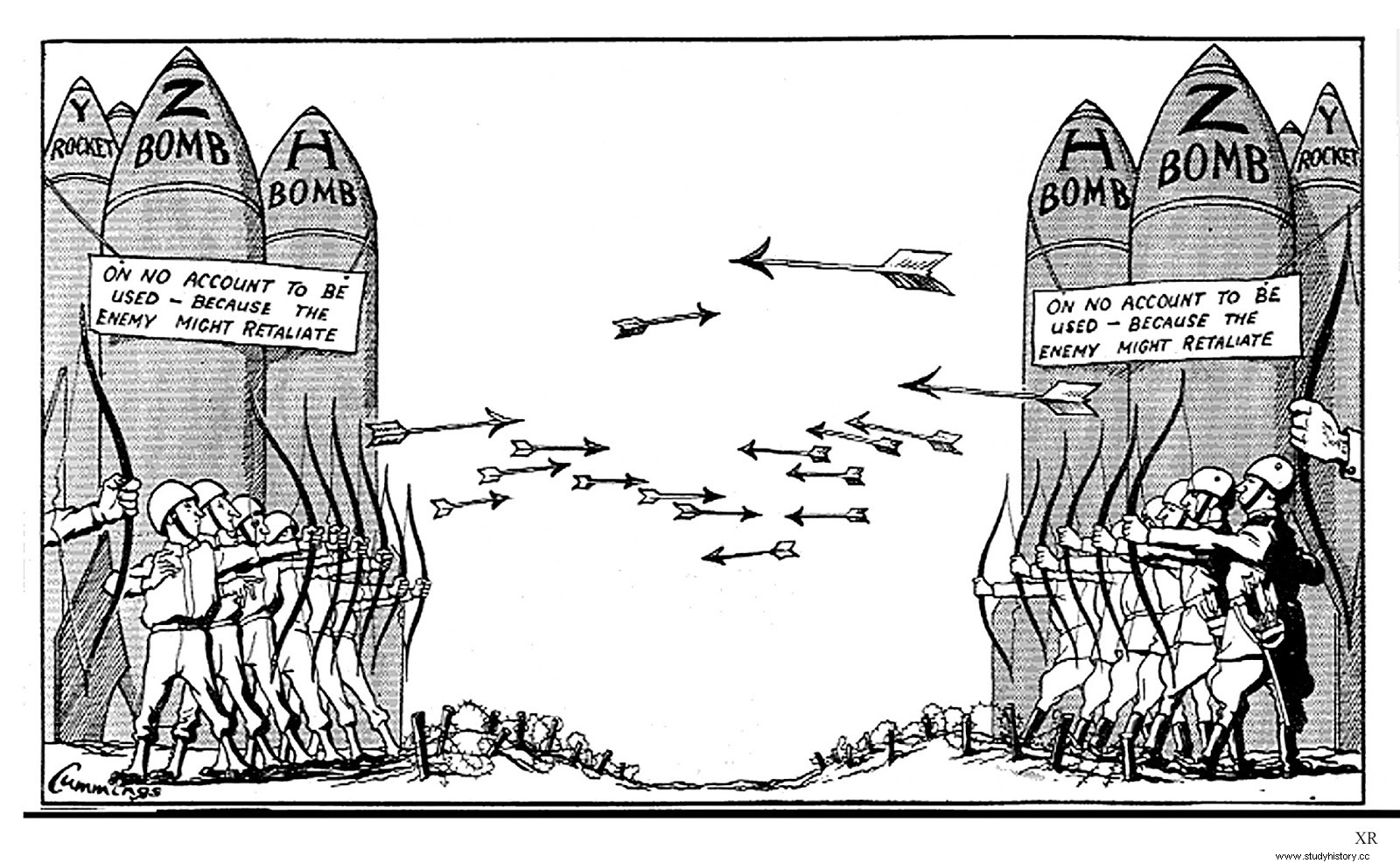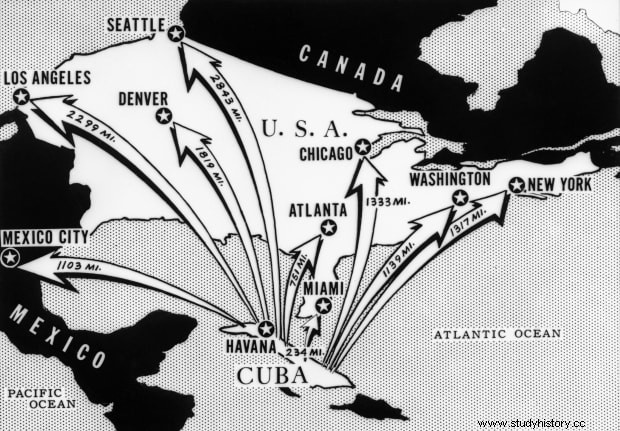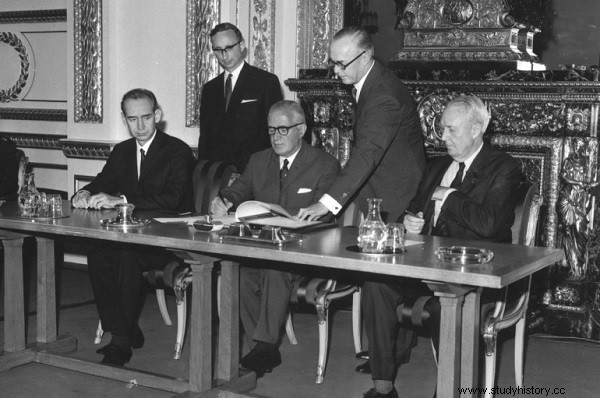Nuclear war. The term itself raises concerns for world leaders. In the last 100 years, nuclear weapons have led to total destruction. This led to countries competing, head-to-head, with each other in a nuclear arms race. The world's nuclear forces refuse to give up their research and possession of nuclear weapons and technology, for fear of vulnerability.
An example of the fear that comes from nuclear weapons is the Taliban's takeover of Afghanistan. US lawmakers advise President Joe Biden to ensure that the Taliban do not undermine Pakistan's defense. If they do, there is a possibility that the Taliban will take control of Pakistan's nuclear weapons.
The origins and history of nuclear weapons led to distress and fear, no matter how many people try to prevent or justify the spread of nuclear technology.
The origin of atomic bombs

Weapons of mass destruction, atomic bombs release explosive energy.
A sidewalk in London
Leo Szilárd, a Hungarian physicist, walked off a sidewalk in London on September 12, 1933. At that moment, he was thinking of a nuclear chain that releases and utilizes energy in atoms simultaneously.
Nuclear weapons exploit the forces that hold the nuclear nucleus together. The nucleus contains the entire atomic mass. When the particles in the nucleus (protons and neutrons) split or fuse together, energy is released, resulting in either nuclear fusion or nuclear fission.
Nuclear fusion is when the nucleus of the atom divides into two small fragments of a neutron.
Nuclear fission is two small atoms that come together to form a larger one.
Although the processes are different, each one causes great destruction.
Atomic Bomb
The atomic bomb, atomic bomb or nuclear bomb was created through nuclear fusion. When a neutron hits a nucleus in an atom of radioactive material, two or three neutrons are released. Energy release is when neurons are split from the nucleus. Therefore, there is an immediate chain reaction.
Hydrogen bomb
Atomic energy, also known as the 'H-bomb', is released by fusing light nuclei at high temperatures, resulting in heavier atoms. The total mass of the heavier core is less than the mass of the two original cores. Therefore, the remaining mass becomes energy.
The difference in mass disturbs the balance, disturbs the energy that binds the heavier core. Hence an unstable core.
This is where the term 'thermonuclear' comes in, due to the high temperatures required.
Hydrogen isotopes fuse together, giving it the name 'hydrogen bomb'. In addition, it has a higher destructive power than the atomic bomb.
The Manhattan Project

A code name for a joint effort during World War II. Part of this joint effort was the US government, along with the industrial and scientific sectors.
The reason behind the formation
The Manhattan project was a response to the fear of German scientists who excel in their knowledge of nuclear weapons. In addition, the United States feared that the Germans were already ten years ahead of them.
A major concern was Adolf Hitler, who used nuclear weapons. In addition, he controlled uranium mines in Czechoslovakia and bought uranium abroad. If this was not enough of a concern, the foremost nuclear scientist, Dr. Klaud Clusius, worked for him.
Years after Szilárd's thought, Lise Meitner, an Austrian scientist, and Otto Frisch, a physicist, made it a reality. They concluded that an atom of uranium flooded with neutrons would extend until it split in two. Frisch called this 'nuclear fission'. In addition, they concluded that large amounts of energy create a chain reaction. Therefore, Szilárd's idea was achievable.
The Warning
Szilárd and Eugene Wigner, another Hungarian scientist, sought to warn world leaders of Germany's discovery. Visiting Albert Einstein, they informed him that his equation, E =mc², would probably be used by Nazi Germany to make nuclear weapons. Einstein's equation theorizes that small masses can unleash enormous energy.
On August 2, 1939, Einstein signed a letter to US President FD Roosevelt. He warned of a new energy source and Nazi Germany's potential development of nuclear weapons.
Shortly after receiving the warning, Roosevelt set up a committee to investigate. The United States also conducted nuclear research, but development was slow.
The formation
In August 1942, the Manhattan Project was created. Named after the first offices in Manhattan, the misleading name hid its purpose. Eventually, the headquarters moved to Washington, while many project areas spread across the country.
Remarkable Members
Many physicists, chemists, metallurgists (studying the properties and uses of metals), explosives experts and military personnel were part of the Manhattan project. Here are some key members:
- J. Robert Oppenheimer, an American physicist known as the 'Father of the Atomic Bomb'.
- Leo Szilárdmed Enrico Fermi and the engineering team, developed the first self-supporting nuclear chain reaction.
- Hans Bethe, a German-American nuclear physicist and head of the theoretical division, was responsible for discovering important aspects of physics that made the atomic bomb possible.
- Ernest O. Lawrence, an American nuclear physicist and program manager, invented the cyclotron that helped with production. His assignments included research on the electromagnetic separation of atoms for the atomic bomb. Klaus Fuchs, a German theoretical physicist, contributed many important theories. However, his infamy lies in being a spy for the Soviet Union.
The location of the weapons research laboratory was Los Alamos, Mexico. The group of scientists built and tested the first atomic bomb.
In 1945, at Los Alamos, scientists created two different bombs:
- "Little Boy", a uranium-based design.
- "Fat Man", a plutonium-based design.
July 16, 1945, the nuclear age officially began.
The first atomic bomb tested was at the Trinity Site in the New Mexico Desert. The result, along with complete destruction, was a huge mushroom cloud at 40,000 m high.
Nuclear power in Japan

At the time of the Trinity Site test, Allied powers defeated Nazi Germany in Europe. Japan, however, tried to fight to the end in the Pacific, although there were no indications of victory.
Japan proved to be more dangerous when they were defeated, especially in July 1945. They caused Allied casualties.
The United States, Britain, and China set an ultimatum for Japan's unconditional surrender. The Potsdam Declaration. Japan, however, rejected the Allies' demand for surrender. Their response met with a threat of destruction.
Hiroshima
The first goal, a production center of 350,000 people.
A 9,000-kilo uranium bomb was dropped on a B-4 bomber.
On the morning of August 6, 1945, "Little Boy" parachuted and exploded 2 m above Hiroshima.
The atomic bomb was engulfed by the city and brought a dazzling glimpse of heat and light. Bronze statues fused and roof tiles fused together. The exposed skin of those far from the Hiroshima explosion was burned by the intense radioactive energy.
Nearly 80,000 people died immediately.
Even after the deaths and destruction, however, Japan refused to surrender.
Nagasaki
Due to poor visibility, the first second target, Kokura, was unharmed. Instead, the plane went to Nagasaki, a port city with 263,000 people, including military factories.
Like Hiroshima, it did not suffer the first American bombings during the war
"Fat Man", an implosive plutonium unit, had a greater complexity than "Little Boy".
The decision to use "Fat Man" days after Hiroshima came from two observations:
- the changing Japanese weather (a major weather event can delay distribution).
- two bombings could finally lead to Japan's surrender.
40% more powerful than "Little Boy", the primary target was the military factories.
The surrounding hills managed to contain the first explosion and limit the damage.
The result:14,000 homes destroyed and people evaporating near the blast. Those within the radius of the explosion burned, probably died of radiation poisoning.
After an initial sum of 30,000 deaths in 1946, five years later revealed a total of 100,000 deaths related to the bombing in Nagasaki.
Not only did the bombing affect Japan's decision, but the Soviet Union declared war on Japan. Emperor Hirohito gathered with the Council of War. Shortly afterwards, as a decision was made on the emperor's will, Japan sent a message to the United States accepting the Potsdam Declaration.
The Cold War

The foundations of the Cold War began with control of the conquered territories of Eastern Europe.
In the beginning, only the United States had nuclear weapons.
In 1949, the Soviet Union tested its first atomic bomb. This began the nuclear arms race. That's why countries started making more and bigger bombs.
In 1952, the United States tested the hydrogen bomb for the first time. The Soviet Union followed with its version in 1953.
However, with the United States at the forefront of hydrogen bombs, the Soviet Union sent in a network of spies. Hence international espionage. The spies shared American drawings of the hydrogen bomb, in addition to discovering regional sources of uranium in Eastern Europe.
As a result, nuclear testing and research became high-profile targets for several countries.
Cuban Missile Crisis

The Cuban Missile Crisis was a 13-day political and military stand-off in October 1962. Participants:Leaders of the United States and the Soviet Union.
The Soviet Union installed nuclear weapons in Cuba. This was 90 kilometers from American shores. A US spy plane secretly photographed the Soviet Union while building its nuclear missile site.
US President JF Kennedy warned the Americans about the missile after being made aware of the information. He then announced the decision to have a naval blockade around Cuba. Their intentions were clear. The United States was prepared to use military force from the naval blockade (if necessary) to counter the perceived threat.
On the other hand, both leaders saw the terrible possibility of nuclear war.
They made a deal.
As part of the agreement, the Soviet Union dismantled its weapons base in Cuba and removed the missiles. The United States has promised not to invade Cuba
A separate agreement, a 25-year-old secret, mentions that the United States has agreed to remove its nuclear missiles from Turkey.
Even though the crisis was over, the nuclear arms race was not.
Nuclear Non-Proliferation Treaty (NPT)

The NPT is an agreement signed by major nuclear and non-nuclear powers. It swore cooperation to reduce the spread of nuclear technology.
Seen as a success for arms control advocates, it was a step towards preventing nuclear proliferation.
Nuclear proliferation: Dissemination of nuclear weapons, nuclear weapons technology or distributable material to others who do not already have them. (britannica.com)
The goal of PT is:
- prevent the proliferation of nuclear weapons and nuclear technology,
- to promote cooperation on the peaceful use of nuclear power, and
- further achieve the goal of nuclear disarmament, as well as general and complete disarmament.
In 1961, 16 years after the US atomic bombs fell on Japan, the UN called for a treaty. Without the treaty, about 25 countries could have acquired nuclear weapons.
The UN resolution called on the United States and the Soviet Union to draft what they would include in the treaty. Their drafts became the basis for negotiations.
A total of 190 countries signed the treaty.
Five of these countries have nuclear weapons:the United States, Britain, France, Russia and China.
Yet there are countries that have nuclear weapons that have not signed it:India, Pakistan, Ireland and North Korea. North Korea withdrew from the treaty in 2003.
Treaty on the Prohibition of Nuclear Weapons

This Treaty entered into force on 22 January 2021.
The purpose of the treaty is to reduce the consequences of testing nuclear weapons. It requires countries to help victims of nuclear testing and use, as well as clear the polluted areas.
It bans nuclear weapons. Countries are prohibited from producing, testing, acquiring, owning and / or storing nuclear weapons. The transfer of weapons is prohibited. It prohibited the signatories from allowing nuclear technology to be stationed, installed and / or distributed in their territories.
Some of the world's nuclear powers have not signed the treaty, including the United States and Russia.
Some say it is a step towards total disarmament. Others, who probably have nuclear weapons, say that it undermines NPT. However, it is stated that TPNW does not undermine NPT. Instead, it adds and reinforces its goals.
All in all, the real reason behind the treaty is to bring international understanding that the use of nuclear weapons is unacceptable.
the conclusion
Nuclear weapons led to major destruction in the past. In the present, they give fear and worry.
Since development, it has become part of the endless struggle for countries to gain the upper hand over each other. Even if nuclear weapons are not in use, they are an underlying threat to those who have them and those who do not. The threat is growing with the Taliban's control of Afghanistan. The impending fear of what to do with a single bomb or missile will never go away.
From what the past shows us, no matter how noble the cause may seem, the use of nuclear weapons brings more than a message.
"Weapons of war must be abolished before they can be abolished."
- John F. Kennedy.
